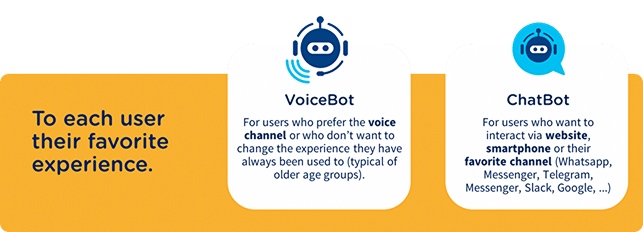
By now, you’re probably already familiar with the term “omnichannel” applied to customer service. In this article, we dive into definitions, benefits, and use cases to help you really understand what omnichannel means and how you can leverage omnichannel services to unify and improve customer and employee experience.
Omnichannel Customer Service. What does it mean?
Omnichannel customer service integrates multiple communication channels into a unified and seamless customer experience, giving customers the opportunity to reach you by phone, email, live chat, social media, instant messaging apps, and more, and to switch between them as they see fit without having to repeat information or start over. The goal is to provide customers with a consistent and personalized service across all touchpoints, thus improving customer satisfaction, loyalty, and overall brand reputation.
Are omnichannel or multichannel services the same thing?
Fair question. The quick answer would be ‘no’.
For instance, a customer may start a conversation with a business through the live chat after browsing the website while commuting. Imagine they go through a tunnel and Internet cuts off, so the customer picks up the phone to continue the conversation.
In a multichannel strategy, the conversation would restart from the beginning, with the customer having to recap what they already said via chat. In an omnichannel strategy, the process picks up where it was left off on the chat without the need of any recap.
In other words, with an omnichannel system running, a customer may start a conversation with a company through social media, then switch to a live chat session, and finally get assistance over the phone, all without having to start the process from scratch.
Why is omnichannel customer service on the rise?
In the new era, customers have a frenetic life. They probably get in touch with you while travelling, doing house work, even grocery shopping, and more. This means that they cannot always call you via phone but probably they would like to send you a message from the tools they’re used to have open on their phone, such as WhatsApp or Telegram.
Another aspect we need to care about is the type of request they have. In case they just need to know what time you’re open for business, or get in touch with a low value information from you they are more likely to search on your website by sending a chat or getting in touch with you with the channels you provide. But let’s not forget that65% of users still prefer phone calls, which means that the voice channel can’t be overlooked in favor of a digital approach. In fact, for more complex or important topics, they probably would like to speak with someone to better discuss deeper some details. For example, in a bank, this might be the case of discussing a change or upgrade in one’s banking account.
And there you have it! To summarize, the basic reasons why omnichannel customer service is on the rise are the increasingly higher accessibility to digital services and faster life rhythms, without giving up on the most loved channel of all: voice. Let’s add a layer of context with a few market trends.
1. Changing customer preferences: as already stated, today’s customers expect to interact with companies through various channels and want to have the flexibility to switch between them as needed. Offering an omnichannel customer service experience allows companies to meet these evolving customer expectations.
2. Increased competition: the rise of e-commerce and digital technologies gives customers more options than ever before. Companies that can provide a superior omnichannel customer service experience have a competitive advantage over those that cannot.
3. Data-driven insights: an omnichannel customer service strategy provides companies with a wealth of data that can be used to gain insights into customer behavior, preferences, and pain points. With this information, companies can make data-driven decisions and improve their customer service offerings accordingly, something that’s nearly impossible if one relies on a single-channel, hardly digital strategy.
4. Voice is still the most important channel, with 65% of users preferring phone calls for treating critical matters. It’s fundamental to not overlook the phone channel in favor of digital platforms, and to have it integrated with the other channels for a seamless experience.
How do I implement an omnichannel strategy?
Are you currently using Imagicle Customer Service? Easily add Omnichannel capabilities to the Attendant Console and Operator Essentials.
With Imagicle, it’s as easy as a click. By adding Imagicle omnichannel profile to your Attendant Console or to your Operator Essentials, you’ll be able to manage voice and chat using just one client, the client you’re already used to. You’ll let your customers reach you via Telegram, WhatsApp, Website chat, and more – and you’ll be able to answer to their questions directly from the Attendant Console. If you’re not an Imagicle customer yet, you can easily become one.
Why stopping at omnichannel services? Bring automation to your teams.
Even though markets have different needs, different stages in their digitazion journey, and different channels, by taking a closer look it’s possible to identify some common pain points that an omnichannel + automation strategy can address.
- FAQ 2.0. Something that every business’ website has in common is the evergreen ‘FAQ’ section: indeed helpful, possibly dispersive. Instead of letting a potential customer wandering around your website in search of an answer, what if there was a way to answer to their question via multiple communication channels in a contextualized, automated way?
- Inventory management. Forbes states that US adults are less likely to go to a store if inventory isn’t available online – an omnichannel automated service allows business to have inventory information easily available for customers at all times by providing relevant quick info via chat, WhatsApp, and more.
- Shipping status. If a customer wants to know where their package is, they most likely want to wait 10 seconds max for an answers. If said answer can be provided via WhatsApp at any time of day, allowing them to send a quick text to receive it, they will surely be happy.
- Product research & advice. Who wants to spend hours searching through website pages to find the right product for them? Let alone call a company and spend minutes waiting in line just to ask for advice. It would surely be easier to have a chat available where they can tell you exactly what they’re looking for, right?
- Give customers more control. Nowadays, customers want to feel like they’re ‘in charge’ and have all the control over their buying process. By unifying and integrating all communication channels, the customer will feel at ease and guided through the decision-making process, thus improving the chances for success.
How can I get automation on my omnichannel platforms?
The answer is Imagicle Conversational AI.
Imagicle Conversational AI automates conversations through natural interactions and integrates chat and voice channels with virtual and human agents to improve customer and employee experience.
Every request is managed by a virtual assistant via voicebotor chatbotin real time with the option of transferring to an operator when needed. If you wish to learn more, you can read our Conversational AI blog post.

The use of platforms like Conversational AI is becoming increasingly common, precisely because it brings automation and omnichannel features.
Imagicle Conversational AI is natively integrated with your calling platform (Cisco, Microsoft, etc.) and Imagicle’s inbound call management solutions without the need for additional lines or telephone numbers.
The use cases are many. Why don’t you see it in action?




